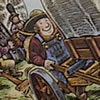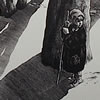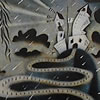Beyond Oz
Welcome to Beyond Oz: An Online Gallery
The artists of Beyond Oz invite you to travel over the rainbow with them: Climb a "Kansas Mountain" and ride a tractor. Ride a train or a riverboat. Kiss dragons good night and take a mud bath with frogs. Bike through the fields with Little Red Riding Hood and go to Diffendoofer School. Search for the alphabet in the world around you. It will be the beginning of a wonderful, magical journey into the world of children’s books.
Also see: Beyond Oz Museum exhibition information



History of Children's Book Illustration
Regional children’s book illustration dates from around the beginning of the 20th century. Kansas’s native son, John Steuart Curry began his career as an illustrator of children’s books and magazines. Two-time Caldecott Honors winner Jean Charlot, who worked with renowned children’s writers Margaret Wise Brown, Joseph Krumgold, and Ann Nolan Clark, served as director of the Colorado Springs Fine Arts Center in the 1950s. Noted Native American artist Alan Houser, who grew up in Oklahoma, attended the Santa Fe Indian School and helped found the Native American Institute of Art, illustrated three children’s books on Indian topics. C. W. Anderson, much beloved for his illustrated children’s books about horses, hailed from Nebraska, as did Rose Cecil O’Neill, the mother of the Kewpie doll and books.



Today's Artist
Current technologies, such as photo-offset printing, allow today’s illustrator to work in a wider variety of media than artists of the past. The collage work of Lane Smith and Cathryn Falwell and the beautiful color images of many of the artists would not be possible with photo-offset presses. In addition, artists like Eric Brace, Bob Staake, and Stephen T. Johnson have used computers to generate their images.
Today’s artist understands that children’s untutored eye sees all the page has to offer, and fantastical characters by such artists as Lane Smith and Eric Brace cavort in our galleries with the stunning pastel and acrylic children by Thomas B. Allen, Tim Ladwig, Stephen T. Johnson, and Floyd Cooper and with G. Brian Karas’ childlike Fred, "The Class Artist." Concept books range from the whimsical and modern computer-generated alphabet and counting books of Bob Staake, to the Lupine Award winning, cut paper Turtle Splash! Countdown at the Pond, by Cathryn Falwell, to the stunning trompe l’oeil alphabet of Stephen T. Johnson, which won Caldecott Honors in 1996.
Enhancing the Story Through Art
Children’s book illustrators have a difficult job. Unlike the artist who creates a self-contained piece, the illustrator works within the constraints of the "book." In a picture book, each illustration must respond to the story. While the artists may interpret and add details, it is not their job to retell a tale. At the same time, the illustrator is responsible for enhancing the story through visual cues. The artist also needs to layer the illustrations, so that each reading brings new visual discoveries. Finally, the illustrator is the person who "sells" the book. If the cover and interior illustrations don’t visually attract the consumer, whether it be child or parent, the book remains unread!